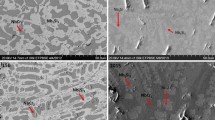Abstract
The fundamental oxidation characteristics of two U-base alloys, U-16.6 at.% Nb-5.6 at.% Zr and U-21at.% Nb, in the temperature range 500–1000° C in oxygen at 0.05 Torr are described. Both alloys undergo large dimensional changes during oxidation at temperatures above 650° C due to stresses generated in the oxide during oxidation. Oxidation rate curves for both alloys were determined at 100° C intervals between 500 and 1000° C; the activation energy for the process is shown to be small. The morphology of the oxide scale formed on the two alloys is complex and is described in detail. Stresses estimated at 106 psi are shown to develop in oxidizing specimens, and a mechanism for the generation of these stresses is proposed.
Similar content being viewed by others
References
C. W. Dean, M.S. Thesis, University of Tennessee, 1969.
H. L. Yakel,J. Nucl. Mater. 33, 286 (1969).
R. E. Pawel and J. V. Cathcart,J. Electrochem. Soc. (in press).
C. A. Phalnikar and W. M. Baldwin,Am. Soc. Test. Mater. 51, 1038 (1951).
F. N. Rhines and J. S. Wolf,Met. Trans. 1, 1701 (1970).
O. Kubaschewski and B. E. Hopkins,Oxidation of Metals and Alloys (Butterworths, London, 1962), Chap. 4, p. 213.
H. R. Hoekstra,Uranium Dioxide: Properties and Nuclear Applications, J. Belle, ed. (U.S. Government Printing Office, Washington, D.C., 1961), Chap. 6, p. 233.
Ibid., p. 246.
J. Belle,J. Nucl. Mater. 30, 3 (1969).
K. W. Lay,J. Am. Ceram. Soc. 57, 369 (1970).
I. Cohen and B. E. Shaner,J. Nucl. Mater. 9, 18 (1963).
J. P. Coughlin,Contributions to the Data of Theoretical Metallurgy. XII. Heats and Free Energies of Formation of Inorganic Compounds, Bulletin 542, Bureau of Mines (U.S. Government Printing Office, Washington, D.C., 1954); E. Fromm,J. Less Common Metals 14, 113–125 (1968).
J. V. Cathcart, J. J. Campbell, and G. P. Smith,J. Electrochem. Soc. 105, 442 (1958).
R. E. Pawel, J. V. Cathcart, and J. J. Campbell,J. Electrochem. Soc. 110, 551 (1963); R. E. Pawel and J. J. Campbell,J. Electrochem. Soc. 116, 828 (1969).
H. K. Hoekstra,Uranium Dioxide: Properties and Nuclear Applications, J. Belle, ed. (U.S. Government Printing Office, Washington, D.C., 1961), Chap. 6, p. 230.
R. E. Pawel and J. J. Campbell,Acta Met. 14, 1827 (1966).
J. V. Cathcart and G. F. Petersen, to be published.
Author information
Authors and Affiliations
Additional information
Research sponsored by the U.S. Atomic Energy Commission under contract with the Union Carbide Corporation.
Rights and permissions
About this article
Cite this article
Cathcart, J.V., Pawel, R.E. & Petersen, G.F. The oxidation properties of U-16.6 at.% Nb-5.6 at.% Zr and U-21 at.% Nb. Oxid Met 3, 497–521 (1971). https://doi.org/10.1007/BF00604997
Received:
Issue Date:
DOI: https://doi.org/10.1007/BF00604997




